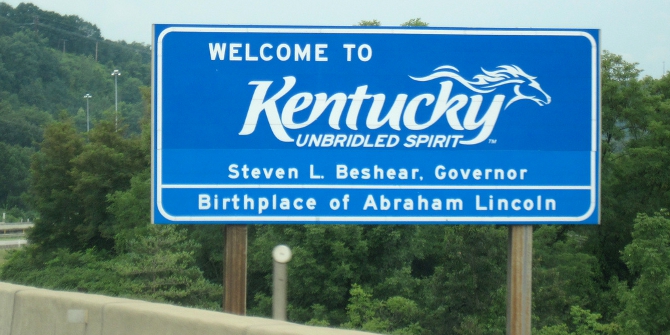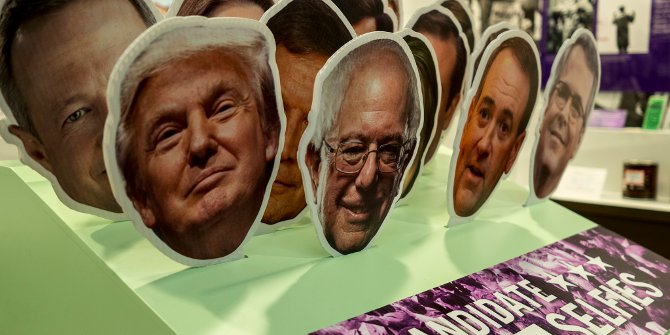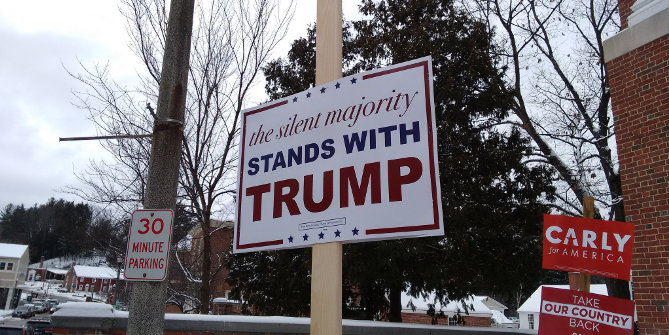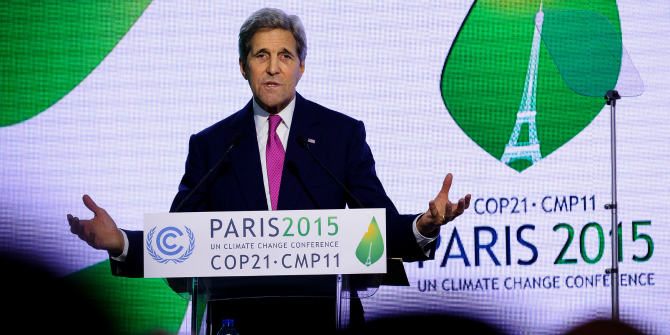 In June 2018, the Supreme Court ruled that the state of Ohio could remove people from its voter rolls if they had not voted in two elections, and then failed to respond to follow-up letters. Todd Donovan writes that the decision may lead to thousands more voters being removed from rolls in Republican-led states like Alabama, Georgia and Pennsylvania, with many of those likely to be removed being from minority groups.
In June 2018, the Supreme Court ruled that the state of Ohio could remove people from its voter rolls if they had not voted in two elections, and then failed to respond to follow-up letters. Todd Donovan writes that the decision may lead to thousands more voters being removed from rolls in Republican-led states like Alabama, Georgia and Pennsylvania, with many of those likely to be removed being from minority groups.
In June 2018, the US Supreme Court passed up an opportunity consider a measure of partisan advantage (or “sociological gobbledygook”) when evaluating partisan gerrymandering. The non-decision in Gill v. Whitford left in place district maps that grant advantages to eight Republican state governments that might control congressional redistricting in 2021. Given the stakes of redistricting, Gill was closely followed. Less noticed was a decision on June 11, where the majority upheld relatively arcane election procedures supported by the Trump Administration and opposed by the Obama Administration and civil rights attorneys.
Purging the dead, the lazy, or both
In Husted v. Randolph, the Court (in a 5-4 vote) granted states latitude in determining when infrequent voters could be purged from registration rolls. At issue was whether Ohio was removing people from the rolls simply for failing to vote. Registered voters die, move, and many don’t vote regularly. Dead voters don’t remove themselves from the rolls, and may not be distinguished from infrequent voters or those who moved. This requires an administrative balancing act between robust rolls, and accurate records.
Federal laws, state implementation
America’s decentralized election administration leaves this to states and counties. Local officials ‘balance’ matters by trying to match voter records with death reports, drivers’ license changes, and address records. They also have a history of using purges to remove minority voters.
The intent of the 1993 National Voter Registration Act (NVRA), also known as the “Motor Voter Act”, was to provide greater opportunities for registration, as when applying for a driving license. The Act also prohibited states from purging registered voters solely on the basis of not voting. Congress also feared non-voter purges would disproportionately affect minorities.
The Democrats’ version of the NVRA allowed removal only “by reason of death, criminal conviction, mental incapacity, change in residence, or voter request.” But the Act contained a provision added in conference committee authorizing removing registrations in the case of an “undelivered (returned) notice” made by mail.
The 2002 Help America Vote Act (HAVA) amended NVRA to allow states to remove registered voters who failed to return a card asking if they wished to remain on the voter rolls. NVRA as amended by HAVA seems to allow states two methods to notify “inactive” voters – one that relies on the postal service returning undelivered notices from a dead address, another which requires inactive voters to actively respond to a notice.

“I voted” by IIP Photo Archive is licensed under CC BY NC 2.0
After not voting in two general elections, states may purge an inactive registration. Inactives remains on the rolls, but must update their records if they vote. NVRA had been seen as allowing purges of inactive registrations only after a state received independent and affirmative indication that a person moved or died.
Registered voters are responsible for not being dead
Research confirmed what the NVRA Congress feared, finding higher rates of inactive status in Hispanic jurisdictions. Those challenging Ohio’s practice argued the trigger for being notified and purged was non-voting, and thus a violation of NVRA. Many other states purge only after documents sent to the registered address are returned undeliverable and/or after an official assumes the burden of documenting a person is no longer at an address.
If someone misses one federal election in Ohio, they are mailed a notice. If they again fail to vote, and failed to actively respond to a second notice, they are purged. Seventy-percent of inactive Ohioans who were sent notices didn’t return them. With Husted giving this the thumbs-up this, the court is clearing the way for more states to follow. Alabama, Georgia, and Pennsylvania use similar practices.
What (partisan) difference does it make?
Thousands of eligible voters were reported to have been removed by Ohio’s purges. Even prior to Husted, Alabama’s Republican Secretary of State, John Merrill was vocal about ‘refreshing’ voter lists, creating confusion over inactive status and reported problems in the state’s 2016 election. Political scientists have studied the potential turnout and partisan effects, and “perverse consequences” of implementing the NVRA’s “Motor Voter” provisions, but the heart of Husted seems to be that NVRA may no longer prevent states from purging people for not voting.
Little is known about how Husted will play out. We do know that procedures that constrain access to voting and target demobilization of minority voters diffuse across Republican-controlled states. We also know Republican voters support barriers to voting, and feel better about stricter regulations on voting. We might expect rapid registration purges as another tool – along with reduced early voting, shorter polling place hours, strict photo ID rules, and minority vote dilution – that are available to Republican-controlled state governments. Election day registration might obviate the need for purges, but Republicans are less likely to support it.
Is this about federalism, or partisan power?
Husted marks another case where the Republican Supreme Court advanced election rules that might be seen to benefit Republicans, or, at the least, to “put a thumb on the scale” of justice.
There is a pattern here: Citizens United (5-4, deregulating campaign finance); Shelby County v. Holder (5-4, gutting Sec. 5 of the Voting Rights Act); Crawford v. Marion County (6-3, upholding photo-ID despite no evidence of fraud – a vote Justice Stevens later regretted), and Abbott v. Perez (also decided 5-4 in June 2018, allowing minority vote dilution and further weakening the VRA). In each case, as with Husted, a Republican majority ruled in favor of election procedures advocated by Republicans, rules that might advantage Republicans.
All of this might fit a pattern of conservative deference to states. In Abbott, the majority voiced a contorted federalism argument saying the court should assume “good faith” of state legislatures when considering if a state’s district maps were crafted with racial discrimination. In Husted, Justice Thomas, likewise, trumpeted state prerogative. The infamous 5-4 vote in Bush v. Gore, however, shows how clearly the alleged federalism principle is moot to the Republican court when election results are at stake.
Please read our comments policy before commenting.
Note: This article gives the views of the author, and not the position of USAPP – American Politics and Policy, nor the London School of Economics.
Shortened URL for this post: http://bit.ly/2KF72Gz
About the author
 Todd Donovan – Western Washington University
Todd Donovan – Western Washington University
Todd Donovan is a professor of political science at Western Washington University. His research interests center around elections and opinion in Washington State, the US, and occasionally in Australia, Canada, & Great Britain.






